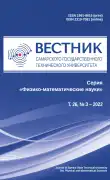General principle of maximum pressure in stationary flows of inviscid gas
- Authors: Sizykh G.B.1
-
Affiliations:
- Moscow Institute of Physics and Technology (National Research University)
- Issue: Vol 26, No 3 (2022)
- Pages: 544-555
- Section: Mathematical Modeling, Numerical Methods and Software Complexes
- URL: https://journals.eco-vector.com/1991-8615/article/view/109730
- DOI: https://doi.org/10.14498/vsgtu1946
- ID: 109730
Cite item
Full Text
Abstract
Within the framework of the Euler equations, the possibility of achieving extreme pressure values at the inner point of a stationary flow of a nonviscous gas is considered. The flow can be non-barotropic. The well-known (G.B. Sizykh, 2018) subsonic principle of maximum pressure (SPMP) cannot be applied in transonic and supersonic flow regions. Under the conditions of the classical principle of maximum pressure by C. Truesdell (1953), there is no restriction on the values of local Mach numbers, but it has a number of features that do not allow it to be used to verify numerical calculations in the same way as it can be done when using SPMP in subsonic regions. A previously unknown principle of maximum pressure is discovered: a function of derivative flow parameters is found, which must have a certain sign (different for minimum and for maximum pressure) at the point where the pressure reaches a strict or nonstrict local extremum. This principle of maximum pressure is called “general” (GPMP) because its conditions do not include barotropicity, restrictions on the values of local Mach numbers, and the assumption that the gas obeys the Mendeleev–Clapeyron equation. One of the consequences of GPMP is the conclusion that the requirement of barotropicity can be excluded from the conditions of Truesdell's principle of maximum pressure. It is proposed to use GPMP to verify numerical calculations of the ideal gas flow behind a detached shock wave formed in a supersonic flow around bodies and to verify numerical calculations of a viscous gas flow around bodies in regions remote from sources of vorticity, where the effect of viscosity can be neglected.
About the authors
Grigory B. Sizykh
Moscow Institute of Physics and Technology (National Research University)
Author for correspondence.
Email: o1o2o3@yandex.ru
ORCID iD: 0000-0001-5821-8596
SPIN-code: 5348-6492
Scopus Author ID: 6508163390
ResearcherId: ABI-3162-2020
http://www.mathnet.ru/person112378
Cand. Phys. & Math. Sci; Associate Professor; Dept. of Higher Mathematics
9, Institutskiy per., Dolgoprudny, 141700, Russian FederationReferences
- Sedov L. I. A Course in Continuum Mechanics, vol. 2, Physical Foundations and Formulations of Problems. Groningen, Wolters-Noordhoff Publ., 1971, xxi+309 pp.
- Batchelor G. K. An Introduction to Fluid Dynamics. Cambridge, Cambridge Univ. Press, 1967, xviii+615 pp.
- Loytsyansky L. G. Mechanics of Liquids and Gases, International Series of Monographs in Aeronautics and Astronautics, vol. 6. Oxford, Pergamon Press, 1966, xii+804 pp.
- Vyshinsky V. V., Sizykh G. B. The verification of the calculation of stationary subsonic flows and the presentation of the results, Math. Models Comput. Simul., 2019, vol. 11, no. 1, pp. 97–106. EDN: XVQXUH. DOI: https://doi.org/10.1134/S2070048219010162.
- Anikin V. A., Vyshinsky V. V., Pashkov O. A., Streltsov E. V. Using the maximum pressure principle for verification of calculation of stationary subsonic flow, Herald of the Bauman Moscow State Technical University, Ser. Mechanical Engineering, 2019, no. 6, pp. 4–16. EDN: XORYQW. DOI: https://doi.org/10.18698/0236-3941-2019-6-4-16.
- Vyshinsky V. V., Zoan K. T. Numerical simulation of the flow around landscape fragments and solution verification, TsAGI Science Journal, 2020, vol. 51, no. 6, pp. 641–650. DOI: https://doi.org/10.1615/TsAGISciJ.2021037822.
- Airapetov A. B., Vyshinsky V. V., Katunin A. V. On the verification of calculations of stationary subsonic flows around bluff bodies, Uch. Zap. TsAGI, 2021, vol. 52, no. 1, pp. 34–40 (In Russian). EDN: YWTAMA.
- Vyshinsky V. V., Zoan K. T. Aircraft aerodynamics in a disturbed atmosphere, Proc. of MIPT, 2021, vol. 13, no. 2, pp. 40–48 (In Russian). EDN: NJOMFE. DOI: https://doi.org/10.53815/20726759_2021_13_2_40.
- Vyshinsky V. V., Zoan K. T. Atmospheric wind flow of mountain landscape in the surroundings of Danang airport and flight safety problems, Civil Aviation High Technologies, 2021, vol. 24, no. 6, pp. 27–41 (In Russian). EDN: ZNMMDG. DOI: https://doi.org/10.26467/2079-0619-2021-24-6-27-41.
- Airapetov A. B., Vyshinsky V. V., Katunin A. V. Flow around the span structures of the Adler airport bypass road and landing safety issues, Uch. Zap. TsAGI, 2021, vol. 52, no. 6, pp. 41–49 (In Russian). EDN: XFZYOF.
- Vyshinsky V. V., Chinh D. C. Study of aerodynamic characteristics of an aircraft during approach to landing in a disturbed atmosphere, Vietnam J. Mech., 2022, vol. 44, no. 2, pp. 133–152. DOI: https://doi.org/10.15625/0866-7136/16760.
- Brutyan M. A., Vyshinsky V. V., Razdobarin A. M. Application of criteria for independent verification of solutions to improve the numerical calculations quality, Uch. Zap. TsAGI, 2022, vol. 53, no. 4, pp. 26–32 (In Russian). EDN: PPTOCU.
- Truesdell C. Two measures of vorticity, J. Rational Mech. Anal., 1953, vol. 2, no. 2, pp. 173–217. DOI: https://doi.org/10.1512/iumj.1953.2.52009.
- Hopf E. Elementare Bemerkungen über die Lösungen partieller Differentialgleichungen zweiter Ordnung vom elliptischen Typus, Sitzungsberichte der Preußischen Akademie der Wissenschaften, 1927, vol. 19, pp. 147–152 (In German).
- Miranda C. Partial Differential Equations of Elliptic Type. Berlin, Heidelberg, Springer-Verlag, 1970, xii+370 pp. DOI: https://doi.org/10.1007/978-3-642-87773-5.
- Besportochny A. I., Burmistrov A. N., Sizykh G. B. Version of the Hopf theorem, Proc. of MIPT, 2016, vol. 8, no. 1, pp. 115–122 (In Russian). EDN: VSMAAX.
- Sizykh G. B. System of orthogonal curvilinear coordinates on the isentropic surface behind a detached bow shock wave, Fluid Dyn., 2020, vol. 55, no. 7, pp. 899–903. EDN: EZXXWK. DOI: https://doi.org/10.1134/S0015462820070095.
- Sizykh G. B. Second integral generalization of the Crocco invariant for 3D flows behind detached bow shock wave, Vestn. Samar. Gos. Tekhn. Univ., Ser. Fiz.-Mat. Nauki [J. Samara State Tech. Univ., Ser. Phys. Math. Sci.], 2021, vol. 25, no. 3, pp. 588–595 (In Russian). EDN: LRHSER. DOI: https://doi.org/10.14498/vsgtu1861.
- Sizykh G. B. Integral invariant of ideal gas flows behind a detached bow shock, Fluid Dyn., 2021, vol. 56, no. 8, pp. 1027–1030. EDN: FWLWLT. DOI: https://doi.org/10.1134/S0015462821080097.
Supplementary files







